投资学期末试题库答案解析及分析[一]
投资学期末复习练习及答案
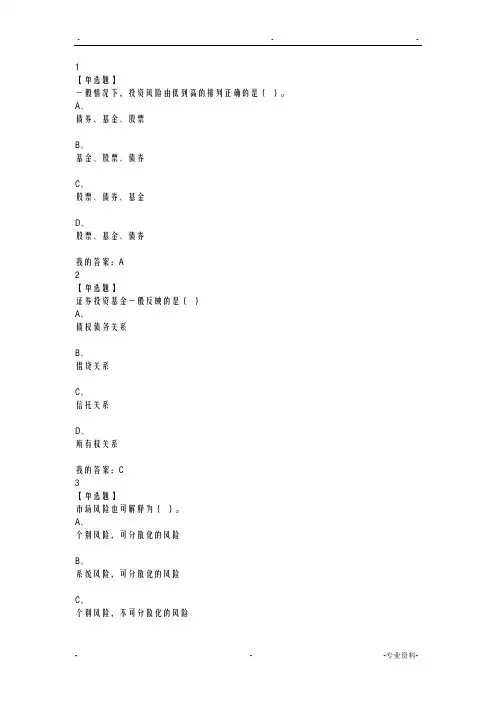
【单选题】一般情况下,投资风险由低到高的排列正确的是()。
A、债券、基金、股票B、基金、股票、债券C、股票、债券、基金D、股票、基金、债券我的答案:A2【单选题】证券投资基金一般反映的是()A、债权债务关系B、借贷关系C、信托关系D、所有权关系我的答案:C3【单选题】市场风险也可解释为()。
A、个别风险,可分散化的风险B、系统风险,可分散化的风险C、个别风险,不可分散化的风险系统风险,不可分散化的风险我的答案:D4【单选题】某个投资者的最优投资组合是由()决定的。
A、有效边界B、最高无差异曲线C、有效边界和无差异曲线的交点D、有效边界和无差异曲线的切点我的答案:D5【单选题】只能在期权到期日行使的期权是()。
A、看涨期权B、看跌期权C、欧式期权D、美式期权我的答案:C6【多选题】基金、股票与债券的区别具体有()。
A、股票反映的是所有权关系,债券反映的是债权债务关系,而基金反映的则是信托关系B、债券筹集的资金主要投向实业,股票、基金所筹集的资金主要投向有价证券等金融工具C、基金是间接投资工具,股票和债券是直接投资工具D、基金的收益有可能高于债券,投资风险有可能小于股票我的答案:ACD7【多选题】在应用移动平均线时,下列操作或说法正确的是()。
A、MA在股价走势中起支撑线和压力线的作用B、MA的行动往往过于迟缓,调头速度落后于大趋势C、在盘整阶段或趋势形成后中途休整阶段,MA极易发出错误的信号D、当股价突破了MA时,无论是向上突破还是向下突破,股价将逐渐回归我的答案:ABC8【多选题】在关于量价关系分析的一些总结性描述中,正确的有()。
A、价涨量增,继续上升B、价涨量减,快速拉升C、价涨量跌,呈现背离D、价跌量增,赶快卖出我的答案:AC9【多选题】根据资本资产定价模型在资源配置方面的应用,以下正确的是()。
牛市到来时,应选择那些低β系数的证券组合B、牛市到来时,应选择那些高β系数的证券组合C、熊市到来之际,应选择那些低β系数的证券组合D、熊市到来之际,应选择那些高β系数的证券组合我的答案:BC10【多选题】我国的境外上市外资股包括()。
国家开放大学电大本科《投资学》2023-2024期末试题及答案(试卷代号:1542)
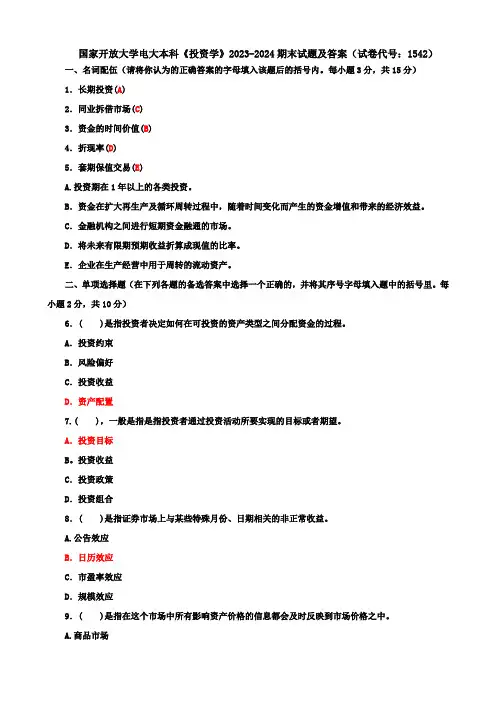
国家开放大学电大本科《投资学》2023-2024期末试题及答案(试卷代号:1542)一、名词配伍(请将你认为的正确答案的字母填入该题后的括号内。
每小题3分,共15分)1.长期投资(A)2.同业拆借市场(C)3.资金的时间价值(B)4.折现率(D)5.套期保值交易(E)A.投资期在1年以上的各类投资。
B.资金在扩大再生产及循环周转过程中,随着时间变化而产生的资金增值和带来的经济效益。
C.金融机构之间进行短期资金融通的市场。
D.将未来有限期预期收益折算成现值的比率。
E.企业在生产经营中用于周转的流动资产。
二、单项选择题(在下列各题的备选答案中选择一个正确的,并将其序号字母填入题中的括号里。
每小题2分,共10分)6.( )是指投资者决定如何在可投资的资产类型之间分配资金的过程。
A.投资约束B.风险偏好C.投资收益D.资产配置7.( ),一般是指是指投资者通过投资活动所要实现的目标或者期望。
A.投资目标B。
投资收益C.投资政策D.投资组合8.( )是指证券市场上与某些特殊月份、日期相关的非正常收益。
A.公告效应B.日历效应C.市盈率效应D.规模效应9.( )是指在这个市场中所有影响资产价格的信息都会及时反映到市场价格之中。
A.商品市场C.有效市场D.垄断市场10.( )是指赋予其购买者在规定期限内,按双方约定的价格购买或出售一定数量某种金融资产的权利合约。
A.远期合约B.金融期权C.金融期货D.金融风险三、多项选择题(在下列各题的备选答案中选择2至5个正确的,并将其序号字母填入题后的括号里。
多选、少选、错选均不得分。
每题3分,共15分)11.从信托标的的角度出发,可以将信托分为( )。
A.贷款信托类B.权益信托类C.单一信托D.融资租赁信托E.不动产信托12.根据资金来源地区和投资地区的不同,可以将基金分为( )。
A.被动型基金B.在岸基金C.公募基金D.离岸基金E.私募基金13.证券投资基金根据其投资标的的不同,可划分为( )。
《投资学》考试题库及答案
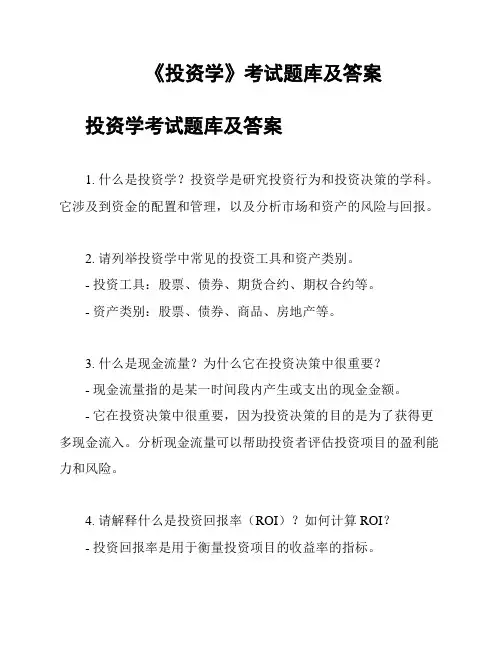
《投资学》考试题库及答案投资学考试题库及答案1. 什么是投资学?投资学是研究投资行为和投资决策的学科。
它涉及到资金的配置和管理,以及分析市场和资产的风险与回报。
2. 请列举投资学中常见的投资工具和资产类别。
- 投资工具:股票、债券、期货合约、期权合约等。
- 资产类别:股票、债券、商品、房地产等。
3. 什么是现金流量?为什么它在投资决策中很重要?- 现金流量指的是某一时间段内产生或支出的现金金额。
- 它在投资决策中很重要,因为投资决策的目的是为了获得更多现金流入。
分析现金流量可以帮助投资者评估投资项目的盈利能力和风险。
4. 请解释什么是投资回报率(ROI)?如何计算ROI?- 投资回报率是用于衡量投资项目的收益率的指标。
- 计算ROI的公式是(投资收益 - 投资成本)/ 投资成本 ×100%。
5. 什么是资本资产定价模型(CAPM)?它有什么作用?- 资本资产定价模型是一种用于估计资产预期回报的模型。
- 它的作用是帮助投资者确定资产的合理价格,并衡量资产的系统风险。
6. 请解释什么是分散投资?为什么分散投资可以降低投资风险?- 分散投资指的是将投资分散到不同的资产或资产类别中。
- 分散投资可以降低投资风险,因为不同资产之间的回报通常是不相关的。
当一个资产表现不佳时,其他资产的回报可能会抵消这种损失。
7. 请说明什么是投资组合?如何构建一个优化的投资组合?- 投资组合是指将多个不同的资产组合在一起形成的投资策略。
- 构建一个优化的投资组合需要考虑资产的回报和风险,以及投资者的目标和偏好。
通过有效的资产分配和风险调整,可以最大化投资组合的回报并降低风险。
8. 请解释什么是市场效率假设?它对投资者有什么影响?- 市场效率假设认为市场价格已经反映了所有可获得的信息,投资者无法通过分析市场信息获得超额收益。
- 对投资者而言,市场效率假设表明他们需要依赖其他策略来获取超越市场平均水平的收益,如选择合适的资产配置和分散投资。
国家开放大学电大本科《投资学》期末题库及答案
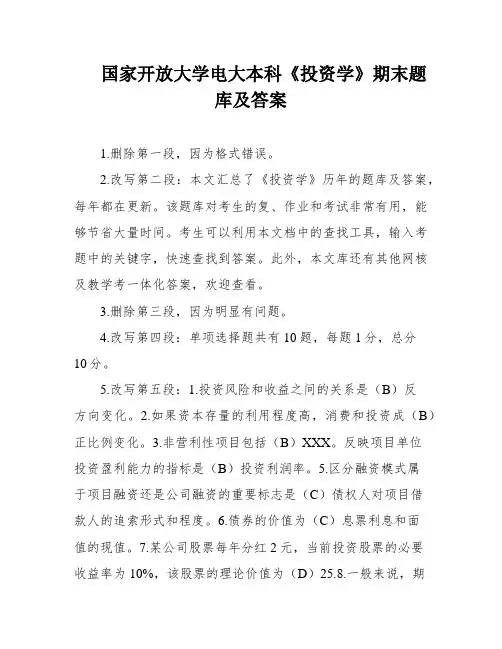
国家开放大学电大本科《投资学》期末题库及答案1.删除第一段,因为格式错误。
2.改写第二段:本文汇总了《投资学》历年的题库及答案,每年都在更新。
该题库对考生的复、作业和考试非常有用,能够节省大量时间。
考生可以利用本文档中的查找工具,输入考题中的关键字,快速查找到答案。
此外,本文库还有其他网核及教学考一体化答案,欢迎查看。
3.删除第三段,因为明显有问题。
4.改写第四段:单项选择题共有10题,每题1分,总分10分。
5.改写第五段:1.投资风险和收益之间的关系是(B)反方向变化。
2.如果资本存量的利用程度高,消费和投资成(B)正比例变化。
3.非营利性项目包括(B)XXX。
反映项目单位投资盈利能力的指标是(B)投资利润率。
5.区分融资模式属于项目融资还是公司融资的重要标志是(C)债权人对项目借款人的追索形式和程度。
6.债券的价值为(C)息票利息和面值的现值。
7.某公司股票每年分红2元,当前投资股票的必要收益率为10%,该股票的理论价值为(D)25.8.一般来说,期权的内在价值(C)大于或等于0.9.当证券持有期收益率(C)小于0,表示投资全部损失。
10.对于成功项目,应选择在成熟期的(C)后期上市。
6.改写第六段:多项选择题共有10题,每题2分,总分20分。
7.改写第七段:11.投资的特征包括经济性、时间性、安全性、收益性和风险性。
12.经济周期可以分为短周期、中周期、中长周期、长周期和超长周期。
13.项目的特点包括收益性、目标性、一次性、整体性、限定性和系统性。
14.非固定收入投资包括股票、期权等。
16.ABCD。
17.ABCD。
18.BC。
19.ABCD。
20.ABCE三、名词解释(每题4分,共20分)21.投资乘数:指投资对国民收入的影响程度,是指国民收入增加1元,投资增加的金额。
22.内部收益率:指使得净现值等于零的折现率,也就是投资项目的收益率。
23.金融期权:是指在未来某个时间点或时间段内,以特定价格买入或卖出某种金融资产的权利。
(完整word版)证券投资分析期末考试题及答案
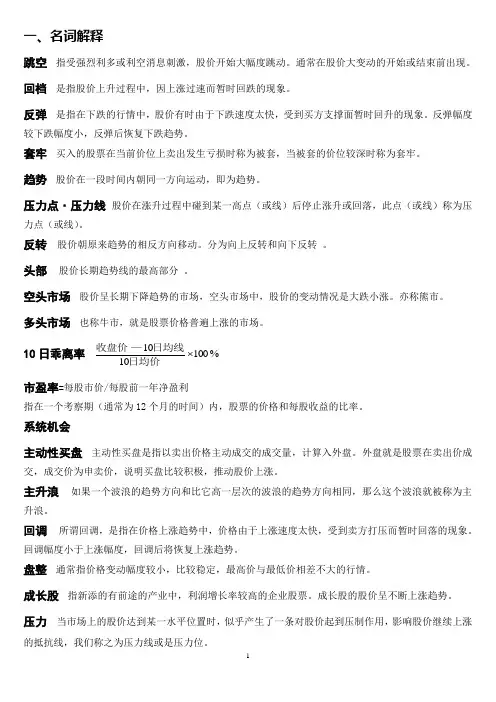
一、名词解释跳空 指受强烈利多或利空消息刺激,股价开始大幅度跳动。
通常在股价大变动的开始或结束前出现。
回档 是指股价上升过程中,因上涨过速而暂时回跌的现象。
反弹 是指在下跌的行情中,股价有时由于下跌速度太快,受到买方支撑面暂时回升的现象。
反弹幅度较下跌幅度小,反弹后恢复下跌趋势。
套牢 买入的股票在当前价位上卖出发生亏损时称为被套,当被套的价位较深时称为套牢。
趋势 股价在一段时间内朝同一方向运动,即为趋势。
压力点·压力线 股价在涨升过程中碰到某一高点(或线)后停止涨升或回落,此点(或线)称为压力点(或线)。
反转 股价朝原来趋势的相反方向移动。
分为向上反转和向下反转 。
头部 股价长期趋势线的最高部分 。
空头市场 股价呈长期下降趋势的市场,空头市场中,股价的变动情况是大跌小涨。
亦称熊市。
多头市场 也称牛市,就是股票价格普遍上涨的市场。
10日乖离率 %1001010 日均价日均线—收盘价 市盈率=每股市价/每股前一年净盈利指在一个考察期(通常为12个月的时间)内,股票的价格和每股收益的比率。
系统机会主动性买盘 主动性买盘是指以卖出价格主动成交的成交量,计算入外盘。
外盘就是股票在卖出价成交,成交价为申卖价,说明买盘比较积极,推动股价上涨。
主升浪 如果一个波浪的趋势方向和比它高一层次的波浪的趋势方向相同,那么这个波浪就被称为主升浪。
回调 所谓回调,是指在价格上涨趋势中,价格由于上涨速度太快,受到卖方打压而暂时回落的现象。
回调幅度小于上涨幅度,回调后将恢复上涨趋势。
盘整 通常指价格变动幅度较小,比较稳定,最高价与最低价相差不大的行情。
成长股 指新添的有前途的产业中,利润增长率较高的企业股票。
成长股的股价呈不断上涨趋势。
压力 当市场上的股价达到某一水平位置时,似乎产生了一条对股价起到压制作用,影响股价继续上涨的抵抗线,我们称之为压力线或是压力位。
支撑当市场上的股价达到某一水平位置时,似乎产生了一条对股价起到支撑作用,影响股价继续下跌的抵抗线,我们称之为支撑线或是支撑位。
《投资学》2021期末试题及答案
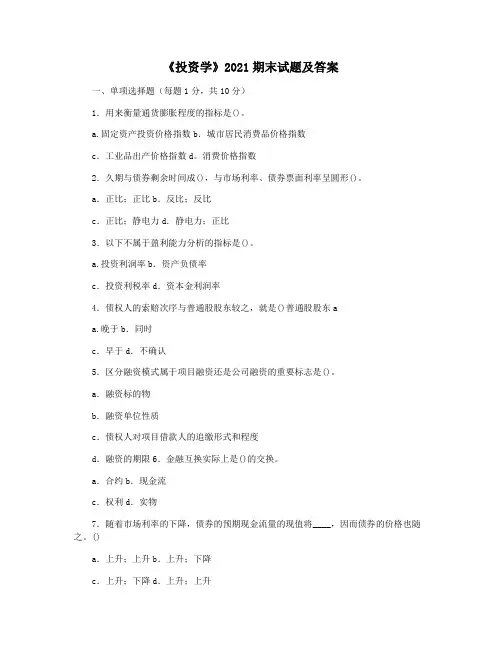
《投资学》2021期末试题及答案
一、单项选择题(每题1分,共10分)
1.用来衡量通货膨胀程度的指标是()。
a.固定资产投资价格指数b.城市居民消费品价格指数
c.工业品出产价格指数d。
消费价格指数
2.久期与债券剩余时间成(),与市场利率、债券票面利率呈圆形()。
a.正比;正比b.反比;反比
c.正比;静电力d.静电力;正比
3.以下不属于盈利能力分析的指标是()。
a.投资利润率b.资产负债率
c.投资利税率d.资本金利润率
4.债权人的索赔次序与普通股股东较之,就是()普通股股东a
a.晚于b.同时
c.早于d.不确认
5.区分融资模式属于项目融资还是公司融资的重要标志是()。
a.融资标的物
b.融资单位性质
c.债权人对项目借款人的追缴形式和程度
d.融资的期限6.金融互换实际上是()的交换。
a.合约b.现金流
c.权利d.实物
7.随着市场利率的下降,债券的预期现金流量的现值将____,因而债券的价格也随之。
()
a.上升;上升b.上升;下降
c.上升;下降d.上升;上升
8.标的资产的价格越低,协议价格越高,看跌期权的价格就越()。
a.高b.低
c.不变d.不确定。
(完整word版)期末复习投资学计算题精选附答案(word文档良心出品).doc
(完整word版)期末复习投资学计算题精选附答案(word文档良心出品).doc投资学计算题部分CAPM模型1、某股票的市场价格为50 元,期望收益率为14%,无风险收益率为6%,市场风险溢价为8%。
如果这个股票与市场组合的协方差加倍(其他变量保持不变),该股票的市场价格是多少?假定该股票预期会永远支付一固定红利。
现在的风险溢价 =14%-6%=8%;β= 1新的β= 2,新的风险溢价=8%×2=16%新的预期收益= 6%+16%=22%根据零增长模型:50=DD=7 14%V=7=31.82 22%2、假设无风险债券的收益率为5%,某贝塔值为1 的资产组合的期望收益率是12%,根据 CAPM模型:①市场资产组合的预期收益率是多少?②贝塔值为零的股票的预期收益率是多少?③假定投资者正考虑买入一股股票,价格是 40 元。
该股票预计来年派发红利 3 美元,投资者预期可以以 41 美元的价格卖出。
若该股票的贝塔值是- 0.5 ,投资者是否买入?①12%,② 5%,③利用 CAPM模型计算股票的预期收益:E(r) =5%+ ( -0.5)×(12%-5%)=1.5%利用第二年的预期价格和红利计算:E(r) =413-1=10% 40投资者的预期收益超过了理论收益,故可以买入。
3、已知:现行国库券的利率为5%,证券市场组合平均收益率为15%,市场上 A、B、C、D 四种股票的β系数分别为0.91 、1.17 、1.8 和 0.52 ;B、C、D股票的必要收益率分别为16.7%、23%和 10.2%。
要求:①采用资本资产定价模型计算 A 股票的必要收益率。
②计算B 股票价值,为拟投资该股票的投资者做出是否投资的决策,并说明理由。
假定 B 股票当前每股市价为15 元,最近一期发放的每股股利为 2.2 元,预计年股利增长率为4%。
③计算 A、 B、 C 投资组合的β系数和必要收益率。
假定投资者购买A、B、C 三种股票的比例为1:3:6 。
投资学复习试题和答案解析
{500t-4000(1+8%)}/500t=25%,解得t=11.52
13.某开放式基金的资产净值是6.3美元每单位,前端费用是10%,那么发行价格是多少?
解:发行价格—发行费用=净值
发行价格(1-费率)=净值
6.3/(1—10%)=7
14.如果某开放式基金的发行价格是12。8美元每单位,前端费用是10%,那么它的资产净值是多少?
投资学
题型;一、选择题6分 二、计算题78分 三、论述题16分(主要是有效市场假说)
1。假设某一中期国债每12个月的收益率是6%,且该国债恰好还剩12个月到期.那么你预期一张12个月的短期国库券的售价将是多少?
解:P=面值/(1+6%)
2.某投资者的税率等级为20%,若公司债券的收益率为9%,要想使投资者偏好市政债券,市政债券应提供的收益率最低为多少?
20.考虑期望收益率为14%,标准差为18%的组合。短期国债的收益率是8%.投资者仍然偏好风险资产所允许的最大风险厌恶系数是多少?
解:无风险资产=8%—1/2A*0=8%、风险资产=14%-1/2A*
由,即14%-1/2A*≥8%
解得A≤3.7
21.考虑以下关于你的风险组合信息,风险组合的期望收益率为11%,风险组合收益率的标准差为15%,无风险利率为5%.
剩余保证金=40×1000+20000-(55×1000+4 ×1000)=1000美元
b.1000/(55×1000)=1。8%〈30%,所以会收到保证金催辑通知。
C。(1000—20000)/20000×100%=-95%
11.假设IBM公司的股价当前为40美元每股,你买入500股,其中16000美元为你的自由资金,剩下的向经纪借入,贷款利率为8%。
投资学期末试题及答案
投资学期末试题及答案一、选择题(每题2分,共20分)1. 投资组合理论是由哪位经济学家提出的?A. 亚当·斯密B. 哈里·马科维茨C. 约翰·梅纳德·凯恩斯D. 米尔顿·弗里德曼2. 以下哪项不是投资风险的类型?A. 市场风险B. 信用风险C. 流动性风险D. 收益风险3. 股票的贝塔系数衡量的是:A. 股票价格波动性B. 股票与市场的关系C. 股票的收益潜力D. 股票的流动性4. 债券的到期收益率与市场利率的关系是:A. 正相关B. 负相关C. 无关系D. 有时正相关,有时负相关5. 以下哪种投资策略不是基于市场效率假说?A. 被动投资B. 技术分析C. 基本面分析D. 指数基金投资二、简答题(每题10分,共30分)1. 请简述资本资产定价模型(CAPM)的基本假设和公式。
2. 什么是有效市场假说(EMH)?它对投资者的决策有何影响?3. 请解释什么是杠杆收购(LBO)以及它在投资中的作用。
三、计算题(每题25分,共50分)1. 假设你拥有一个包含两种股票的投资组合,股票A和股票B。
股票A的预期收益率为12%,股票B的预期收益率为15%。
如果股票A占投资组合的60%,股票B占40%,计算投资组合的预期收益率。
2. 某公司发行了一张面值为1000美元,期限为10年,年利率为5%的债券。
如果市场利率为6%,计算该债券的当前价格。
四、论述题(共30分)1. 论述私募股权投资与公开市场投资的主要区别,并分析它们各自的优点和局限性。
2. 请结合当前市场环境,讨论投资者如何平衡风险与回报。
答案:一、选择题1. B2. D3. B4. A5. B二、简答题1. 资本资产定价模型(CAPM)的基本假设包括:市场是有效的,投资者是理性的,不存在交易成本和税收,投资者可以无限制地借贷资金等。
CAPM的公式为:E(Ri) = Rf + βi * (E(Rm) - Rf),其中E(Ri)是资产i的预期收益率,Rf是无风险利率,βi是资产i的贝塔系数,E(Rm)是市场组合的预期收益率。
《投资学》期末考试客观题及答案
一、单选题1、以下行业中属于周期型行业的是OA.钢铁B.医药C.食盐D.粮食正确答案:A2、根据美林投资时钟,当经济处于高增长、低通胀的时候,最佳的投资标的是OA.债券B.大宗商品C.现金D.股票正确答案:D3、关于波特五力模型的说法错误的是OA.是针对行业的分析B.有一定的局限性,并不适用于所有的情境C.认为有五种竞争力量决定了行业的利润水平D.是针对企业的分析正确答案:D4、向少数特定的投资者发行、审查条件相对较松、监管和公示制度较松的证券是()A.私募证券B.公募证券C.国际证券D.固定收益证券正确答案:A5、下列哪种基金主要投资于境外资产()A.混合型基金B.ETFC.共同基金D.QDII基金正确答案:D6、下列哪一个是正确的?I.风险厌恶投资者拒绝公平游戏的投资II.风险中性的投资者只通过预期收益评价风险资产III.风险厌恶的投资者只通过风险来评价风险资产IV.风险喜好者不参与公平游戏A.只有IB.只有IIC.只有II和IIID,只有I和II正确答案:D7、被动投资。
A.包括大量的交易费用B.包括大量的证券选择C.通过投资于指数共同基金实现D.a和C正确答案:C8、资本资产定价模型中,风险的测度是通过进行的。
A.个别风险B.收益的标准差C.收益的方差D・贝塔正确答案:D9、根据CAPM模型,一个证券的价格为公平市价时,A.阿尔法为正B.贝塔为负值C.贝塔为正值D.阿尔法为零正确答案:D10、资本资产定价模型假设oA.投资者为资本所得支付税款B.所有的投资者都有相同的持有期C.a和b正确D.所有的投资者都是价格的接受者正确答案:C11、如果你相信市场是有效市场的形式,你会认为股价反映了所有通过查看市场交易数据就能够得到的消息。
例如,股价的历史记录、交易量、短期收益率这些信息。
A.半强式B.强式C.a>b和cD.弱式正确答案:D12、传统理论认为投资者____ ,行为金融认为他们oA.是理性的;是理性的B.可能不是理性的;可能不是理性的C.是理性的;是非理性的D.是理想的;可能不是理性的正确答案:D13、信息处理错误包括了o(1)预测错误(2)过度自信(3)保守主义(4)框定偏差A.(3)和(4)C.(1)和(2)D.⑴、(2)和(3)正确答案:D14、在企业被收购或变换经营者的可能性较大时,适宜选用()模型进行估价A.股利折现B.净利润C.股权现金流量D.预期自由现金流量正确答案:C15、与固定利率债券不同,浮动利率债券通常会在特定日期调整利率。
- 1、下载文档前请自行甄别文档内容的完整性,平台不提供额外的编辑、内容补充、找答案等附加服务。
- 2、"仅部分预览"的文档,不可在线预览部分如存在完整性等问题,可反馈申请退款(可完整预览的文档不适用该条件!)。
- 3、如文档侵犯您的权益,请联系客服反馈,我们会尽快为您处理(人工客服工作时间:9:00-18:30)。
TUTORIAL – SESSION 01CHAPTER 011.Discuss the agency problem.2.Discuss the similarities and differences between real and financialassets.3.Discuss the following ongoing trends as they relate to the field ofinvestments: globalization, financial engineering, securitization, and computer networks.CHAPTER 02Use the following to answer questions 1 to 3:Consider the following three stocks:1. The price-weighted index constructed with the three stocks isA) 30B) 40C) 50D) 60E) 70Answer: B Difficulty: EasyRationale: ($40 + $70 + $10)/3 = $40.2. The value-weighted index constructed with the three stocks using adivisor of 100 isA) 1.2B) 1200C) 490D) 4900E) 49Answer: C Difficulty: ModerateRationale: The sum of the value of the three stocks divided by 100 is 490: [($40 x 200) + ($70 x 500) + ($10 x 600)] /100 = 4903. Assume at these prices the value-weighted index constructed with thethree stocks is 490. What would the index be if stock B is split 2 for 1 and stock C 4 for 1?A) 265B) 430C) 355D) 490E) 1000Answer: D Difficulty: ModerateRationale: Value-weighted indexes are not affected by stock splits.4. An investor purchases one municipal and one corporate bond that payrates of return of 8% and 10%, respectively. If the investor is in the 20% marginal tax bracket, his or her after tax rates of return on the municipal and corporate bonds would be ________ and ______, respectively.A) 8% and 10%B) 8% and 8%C) 6.4% and 8%D) 6.4% and 10%E) 10% and 10%Answer: B Difficulty: ModerateRationale: rc = 0.10(1 - 0.20) = 0.08, or 8%; rm = 0.08(1 - 0) = 8%.5. A 5.5% 20-year municipal bond is currently priced to yield 7.2%. Fora taxpayer in the 33% marginal tax bracket, this bond would offer anequivalent taxable yield of:A) 8.20%.B) 10.75%.C) 11.40%.D) 4.82%.E) none of the above.Answer: B Difficulty: ModerateRationale: 0.072 = rm (1-t); 0.072 = rm / (0.67); rm = 0.1075 = 10.75%6. In order for you to be indifferent between the after tax returns on acorporate bond paying 8.5% and a tax-exempt municipal bond paying6.12%, what would your tax bracket need to be?A) 33%B) 72%C) 15%D) 28%E) Cannot tell from the information given.0612 = .085(1-t); (1-t) = 0.72; t = .287. Suppose an investor is considering a corporate bond with a 7.17%before-tax yield and a municipal bond with a 5.93% before-tax yield.At what marginal tax rate would the investor be indifferent between investing in the corporate and investing in the muni?A) 15.4%B) 23.7%C) 39.5%D) 17.3%E) 12.4%tm = 1 - (5.93%/7.17%) = 17.29%Use the following to answer questions 8 to 9:8. Based on the information given, for a price-weighted index of thethree stocks calculate:A) the rate of return for the first period (t=0 to t=1).B) the value of the divisor in the second period (t=2). Assume thatStock A had a 2-1 split during this period.C) the rate of return for the second period (t=1 to t=2).A. The price-weighted index at time 0 is (70 + 85 + 105)/3 = 86.67. Theprice-weighted index at time 1 is (72 + 81 + 98)/3 = 83.67. Thereturn on the index is 83.67/86.67 - 1 = -3.46%.B. The divisor must change to reflect the stock split. Because nothingelse fundamentally changed, the value of the index should remain83.67. So the new divisor is (36 + 81 + 98)/83.67 = 2.57. Theindex value is (36 + 81 + 98)/2.57 = 83.67.C. The rate of return for the second period is 83.67/83.67 - 1 = 0.00%9. Based on the information given for the three stocks, calculate thefirst-period rates of return (from t=0 to t=1) onA) a market-value-weighted index.B) an equally-weighted index.C) a geometric index.A. The total market value at time 0 is $70 * 200 + $85 * 500 + $105 * 300 =$88,000. The total market value at time 1 is $72 * 200 + $81 * 500+ $98 * 300 = $84,300. The return is $84,300/$88,000 - 1 = -4.20%.B. The return on Stock A for the first period is $72/$70 - 1 = 2.86%. Thereturn on Stock B for the first period is $81/$85 - 1 = -4.71%.The return on Stock C for the first period is $98/$105 - 1 = -6.67%. The return on an equally weighted index of the three stocksis (2.86% - 4.71% - 6.67%)/3 = -2.84%C. The geometric average return is [(1+.0286)(1-.0471)(1-.0667)](1/3)-1 =[(1.0286)(0.9529)(0.9333)]0.3333 -1 = -2.92%10.Discuss the advantages and disadvantages of common stock ownership,relative to other investment alternatives.CHAPTER 031. Assume you purchased 200 shares of XYZ common stock on margin at $70per share from your broker. If the initial margin is 55%, how much did you borrow from the broker?A) $6,000B) $4,000C) $7,700D) $7,000E) $6,300Answer: E Difficulty: ModerateRationale: 200 shares * $70/share * (1-0.55) = $14,000 * (0.45) = $6,300.2. You sold short 200 shares of common stock at $60 per share. Theinitial margin is 60%. Your initial investment wasA) $4,800.B) $12,000.C) $5,600.D) $7,200.E) none of the above.Answer: D Difficulty: ModerateRationale: 200 shares * $60/share * 0.60 = $12,000 * 0.60 = $7,2003. You purchased 100 shares of ABC common stock on margin at $70 pershare. Assume the initial margin is 50% and the maintenance margin is 30%. Below what stock price level would you get a margin call?Assume the stock pays no dividend; ignore interest on margin.A) $21B) $50C) $49D) $80E) none of the aboveAnswer: B Difficulty: DifficultRationale: 100 shares * $70 * .5 = $7,000 * 0.5 = $3,500 (loan amount);0.30 = (100P - $3,500)/100P; 30P = 100P - $3,500; -70P = -$3,500;P = $50.4. You purchased 100 shares of common stock on margin at $45 per share.Assume the initial margin is 50% and the stock pays no dividend.What would the maintenance margin be if a margin call is made at a stock price of $30? Ignore interest on margin.A) 0.33B) 0.55C) 0.43D) 0.23E) 0.25Answer: E Difficulty: DifficultRationale: 100 shares * $45/share * 0.5 = $4,500 * 0.5 = $2,250 (loan amount); X = [100($30) - $2,250]/100($30); X = 0.25.5. You purchased 300 shares of common stock on margin for $60 per share.The initial margin is 60% and the stock pays no dividend. What would your rate of return be if you sell the stock at $45 per share?Ignore interest on margin.A) 25%B) -33%C) 44%D) -42%E) –54%Answer: D Difficulty: DifficultRationale: 300($60)(0.60) = $10,800 investment; 300($60) = $18,000 *(0.40) = $7,200 loan; Proceeds after selling stock and repaying loan:$13,500 - $7,200 = $6,300; Return = ($6,300 - $10,800)/$10,800 = -41.67%.6. Assume you sell short 100 shares of common stock at $45 per share,with initial margin at 50%. What would be your rate of return if you repurchase the stock at $40/share? The stock paid no dividends during the period, and you did not remove any money from the account before making the offsetting transaction.A) 20%B) 25%C) 22%D) 77%E) none of the aboveAnswer: C Difficulty: ModerateRationale: Profit on stock = ($45 - $40) * 100 = $500, $500/$2,250 (initial investment) = 22.22%7. You want to purchase XYZ stock at $60 from your broker using aslittle of your own money as possible. If initial margin is 50% and you have $3000 to invest, how many shares can you buy?A) 100 sharesB) 200 sharesC) 50 sharesD) 500 sharesE) 25 sharesAnswer: A Difficulty: ModerateRationale: .5 = [(Q * $60)-$3,000] / (Q * $60); $30Q = $60Q-$3,000; $30Q = $3,000; Q=100.8. You buy 300 shares of Qualitycorp for $30 per share and depositinitial margin of 50%. The next day Qualitycorp's price drops to $25 per share. What is your actual margin?A) 50%B) 40%C) 33%D) 60%E) 25%Answer: B Difficulty: ModerateRationale: AM = [300 ($25) - .5 (300) ($30) ] / [300 ($25)] = .409. You sold short 100 shares of common stock at $45 per share. Theinitial margin is 50%. Your initial investment wasA) $4,800.B) $12,000.C) $2,250.D) $7,200.E) none of the above.Answer: C Difficulty: ModerateRationale: 100 shares * $45/share * 0.50 = $4,500 * 0.50 = $2,25010. List three factors that are listing requirements for the New YorkStock Exchange. Why does the exchange have such requirements?CHAPTER 041. Multiple Mutual Funds had year-end assets of $457,000,000 andliabilities of $17,000,000. There were 24,300,000 shares in the fund at year-end. What was Multiple Mutual's Net Asset Value?A) $18.11B) $18.81C) $69.96D) $7.00E) $181.07Answer: A Difficulty: ModerateRationale: (457,000,000 - 17,000,000) / 24,300,000 = $18.112. Diversified Portfolios had year-end assets of $279,000,000 andliabilities of $43,000,000. If Diversified's NAV was $42.13, howmany shares must have been held in the fund?A) 43,000,000B) 6,488,372C) 5,601,709D) 1,182,203E) None of the above.Answer: C Difficulty: ModerateRationale: ($279,000,000 - 43,000,000) / $42.13 = 5,601,708.996.3. Pinnacle Fund had year-end assets of $825,000,000 and liabilities of$25,000,000. If Pinnacle's NAV was $32.18, how many shares must have been held in the fund?A) 21,619,346,92B) 22,930,546.28C) 24,860,161.59D) 25,693,645.25E) None of the above.Answer: C Difficulty: ModerateRationale: ($825,000,000 - 25,000,000) / $32.18 = 24,860,161.59.4. The Profitability Fund had NAV per share of $17.50 on January 1, 2005.On December 31 of the same year the fund's NAV was $19.47. Incomedistributions were $0.75 and the fund had capital gain distributionsof $1.00. Without considering taxes and transactions costs, whatrate of return did an investor receive on the Profitability fund last year?A) 11.26%B) 15.54%C) 16.97%D) 21.26%E) 9.83%Answer: D Difficulty: ModerateRationale: R = ($19.47 - 17.50 + .75 + 1.00) / $17.50 = 21.26%5. Patty O'Furniture purchased 100 shares of Green Isle mutual fund at anet asset value of $42 per share. During the year Patty receiveddividend income distributions of $2.00 per share and capital gainsdistributions of $4.30 per share. At the end of the year the shares had a net asset value of $40 per share. What was Patty's rate ofreturn on this investment?A) 5.43%B) 10.24%C) 7.19%D) 12.44%E) 9.18%(40-42+2+4.3)/42=10.24%6. A mutual fund had year-end assets of $560,000,000 and liabilities of$26,000,000. There were 23,850,000 shares in the fund at year end.What was the mutual fund's Net Asset Value?A) $22.87B) $22.39C) $22.24D) $17.61E) $19.25Answer: B Difficulty: ModerateRationale: (560,000,000 - 26,000,000) / 23,850,000 = $22.3897. A mutual fund had year-end assets of $465,000,000 and liabilities of$37,000,000. If the fund NAV was $56.12, how many shares must have been held in the fund?A) 4,300,000B) 6,488,372C) 8,601,709D) 7,626,515E) None of the above.Answer: D Difficulty: ModerateRationale: ($465,000,000 37,000,000) / $56.12 = 7,626,5158. A mutual fund had NAV per share of $26.25 on January 1, 2005. OnDecember 31 of the same year the fund's rate of return for the year was 16.4%. Income distributions were $1.27 and the fund had capital gain distributions of $1.85. Without considering taxes andtransactions costs, what ending NAV would you calculate?A) $27.44B) $33.88C) $24.69D) $42.03E) $16.62Answer: A Difficulty: ModerateRationale: .164 = (P - $26.25 + 1.27 + 1.85) / $26.25; P = $27.4359. A mutual funds had average daily assets of $2.0 billion on 2005. Thefund sold $500 million worth of stock and purchased $600 millionworth of stock during the year. The funds turnover ratio is ___.A) 27.5%B) 12%C) 15%D) 25%E) 20%Answer: D Difficulty: ModerateRationale: 500,000,000 / 2,000,000,000 = 25%10. You purchased shares of a mutual fund at a price of $20 per share atthe beginning of the year and paid a front-end load of 5.75%. If the securities in which the find invested increased in value by 11%during the year, and the funds expense ratio was 1.25%, your returnif you sold the fund at the end of the year would be ____________.A) 4.33B) 3.44C) 2.45D) 6.87E) None of the above[20*(1-5.75%)*(1+11%-1.25%)-20]/20=0.034311. List and describe the more important types of mutual funds accordingto their investment policy and use.CHAPTER 051. Over the past year you earned a nominal rate of interest of 10percent on your money. The inflation rate was 5 percent over thesame period. The exact actual growth rate of your purchasing powerwasA) 15.5%.B) 10.0%.C) 5.0%.D) 4.8%.E) 15.0%Answer: D Difficulty: ModerateRationale: r = (1+R) / (1+I) - 1; 1.10% / 1.5% - 1 = 4.8%.2. You purchased a share of stock for $20. One year later you received$1 as dividend and sold the share for $29. What was your holdingperiod return?A) 45%B) 50%C) 5%D) 40%E) none of the aboveAnswer: B Difficulty: ModerateRationale: ($1 + $29 - $20)/$20 = 0.5000, or 50%.Use the following to answer questions 3-5:You have been given this probability distribution for the holding period return for KMP stock:3. What is the expected holding period return for KMP stock?A) 10.40%B) 9.32%C) 11.63%D) 11.54%E) 10.88%Answer: A Difficulty: ModerateRationale: HPR = .30 (18%) + .50 (12%) + .20 (-5%) = 10.4%4. What is the expected standard deviation for KMP stock?A) 6.91%B) 8.13%C) 7.79%D) 7.25%E) 8.85%Answer: B Difficulty: DifficultRationale: s = [.30 (18 - 10.4)2 + .50 (12 - 10.4)2 + .20 (-5 - 10.4)2]1/2 =8.13%5. What is the expected variance for KMP stock?A) 66.04%B) 69.96%C) 77.04%D) 63.72%E) 78.45%A Difficulty: DifficultRationale: s = [.30 (18 - 10.4)2 + .50 (12 - 10.4)2 + .20 (5 - 10.4)2] = 66.04%6. You purchase a share of Boeing stock for $90. One year later, afterreceiving a dividend of $3, you sell the stock for $92. What wasyour holding period return?A) 4.44%B) 2.22%C) 3.33%D) 5.56%E) none of the aboveAnswer: D Difficulty: ModerateRationale: HPR = (92 - 90 + 3) / 90 = 5.56%7. An investor purchased a bond 45 days ago for $985. He received $15in interest and sold the bond for $980. What is the holding periodreturn on his investment?A) 1.52%B) 0.50%C) 1.02%D) 0.01%E) None of the aboveAnswer: C Difficulty: EasyRationale: HPR = ($15+980-985)/$985 = .010152284 = approximately 1.02%.8. Over the past year you earned a nominal rate of interest of 8 percenton your money. The inflation rate was 3.5 percent over the sameperiod. The exact actual growth rate of your purchasing power wasA) 15.55%.B) 4.35%.C) 5.02%.D) 4.81%.E) 15.04%Answer: B Difficulty: ModerateRationale: r = (1+R) / (1+I) - 1 ; 1.08 / 1.035 - 1 = 4.35%.9. Over the past year you earned a nominal rate of interest of 14percent on your money. The inflation rate was 2 percent over thesame period. The exact actual growth rate of your purchasing powerwasA) 11.76%.B) 16.00%.C) 15.02%.D) 14.32%.E) none of the above.10. An investment provides a 2% return semi-annually, its effective annualrate isA) 2%.B) 4%.C) 4.02%D) 4.04%E) none of the above(1.02)2 -1 = 4.04%11. Discuss the relationships between interest rates (both real andnominal), expected inflation rates, and tax rates on investmentreturns.12. Discuss why common stocks must earn a risk premium.CHAPTER 071. Market risk is also referred to asA) systematic risk, diversifiable risk.B) systematic risk, nondiversifiable risk.C) unique risk, nondiversifiable risk.D) unique risk, diversifiable risk.E) none of the above.Answer: B Difficulty: EasyRationale: Market, systematic, and nondiversifiable risk are synonyms referring to the risk that cannot be eliminated from theportfolio. Diversifiable, unique, nonsystematic, and firm-specific risks are synonyms referring to the risk that can beeliminated from the portfolio by diversification.2. The variance of a portfolio of risky securitiesA) is a weighted sum of the securities' variances.B) is the sum of the securities' variances.C) is the weighted sum of the securities' variances and covariances.D) is the sum of the securities' covariances.E) none of the above.Answer: C Difficulty: ModerateRationale: The variance of a portfolio of risky securities is a weighted sum taking into account both the variance of the individual securities and the covariances between securities.3. Other things equal, diversification is most effective whenA) securities' returns are uncorrelated.B) securities' returns are positively correlated.C) securities' returns are high.D) securities' returns are negatively correlated.E) B and C.Answer: D Difficulty: ModerateRationale: Negative correlation among securities results in the greatest reduction of portfolio risk, which is the goal of diversification.4. The Capital Allocation Line provided by a risk-free security and Nrisky securities isA) the line that connects the risk-free rate and the global minimum-variance portfolio of the risky securities.B) the line that connects the risk-free rate and the portfolio of therisky securities that has the highest expected return on theefficient frontier.C) the line tangent to the efficient frontier of risky securitiesdrawn from the risk-free rate.D) the horizontal line drawn from the risk-free rate.E) none of the above.Answer: C Difficulty: ModerateRationale: The Capital Allocation Line represents the most efficient combi nations of the risk-free asset and risky securities. Only C meets that definition.5. Which of the following statements is (are) true regarding thevariance of a portfolio of two risky securities?A) The higher the coefficient of correlation between securities, thegreater the reduction in the portfolio variance.B) There is a linear relationship between the securities' coefficientof correlation and the portfolio variance.C) The degree to which the portfolio variance is reduced depends onthe degree of correlation between securities.D) A and B.E) A and C.Answer: C Difficulty: ModerateRationale: The lower the correlation between the returns of the securities , the more portfolio risk is reduced.Use the following to answer questions 6-11:Consider the following probability distribution for stocks A and B:6. The expected rates of return of stocks A and B are _____ and _____ ,respectively.A) 13.2%; 9%B) 14%; 10%C) 13.2%; 7.7%D) 7.7%; 13.2%E) none of the aboveAnswer: C Difficulty: EasyRationale: E(RA) = 0.1(10%) + 0.2(13%) + 0.2(12%) + 0.3(14%) + 0.2(15%) =13.2%;E(RB) = 0.1(8%) + 0.2(7%) + 0.2(6%) + 0.3(9%) + 0.2(8%) = 7.7%.7. The standard deviations of stocks A and B are _____ and _____,respectively.A) 1.5%; 1.9%B) 2.5%; 1.1%C) 3.2%; 2.0%D) 1.5%; 1.1%E) none of the aboveAnswer: D Difficulty: ModerateRationale: sA = [0.1(10% - 13.2%)2 + 0.2(13% - 13.2%)2 + 0.2(12% -13.2%)2 +0.3(14% - 13.2%)2 + 0.2(15% - 13.2%)2]1/2 = 1.5%; sB = [0.1(8% -7.7%)2 + 0.2(7% - 7.7%)2 + 0.2(6% - 7.7%)2 + 0.3(9% -7.7%)2 + 0.2(8% - 7.7%)2]1/2 = 1.1%.8. The coefficient of correlation between A and B isA) 0.47.B) 0.60.C) 0.58D) 1.20.E) none of the above.Answer: A Difficulty: DifficultRationale: covA,B = 0.1(10% - 13.2%)(8% - 7.7%) + 0.2(13% - 13.2%)(7% -7.7%) +0.2(12% - 13.2%)(6% - 7.7%) + 0.3(14% - 13.2%)(9% - 7.7%) + 0.2(15% -13.2%)(8% - 7.7%) = 0.76; rA,B = 0.76/[(1.1)(1.5)] = 0.47.9. If you invest 40% of your money in A and 60% in B, what would be yourportfolio's expected rate of return and standard deviation?A) 9.9%; 3%B) 9.9%; 1.1%C) 11%; 1.1%D) 11%; 3%E) none of the aboveAnswer: B Difficulty: DifficultRationale: E(RP) = 0.4(13.2%) + 0.6(7.7%) = 9.9%; sP = [(0.4)2(1.5)2 + (0 .6)2(1.1)2 +2(0.4)(0.6)(1.5)(1.1)(0.46)]1/2 = 1.1%.10. Let G be the global minimum variance portfolio. The weights of A andB in G are __________ and __________, respectively.A) 0.40; 0.60B) 0.66; 0.34C) 0.34; 0.66D) 0.76; 0.24E) 0.24; 0.76Answer: E Difficulty: DifficultRationale: wA = [(1.1)2 - (1.5)(1.1)(0.46)]/[(1.5)2 + (1.1)2 -(2)(1.5)(1.1)(0.46) = 0.23;wB = 1-0.23 = 0.77.Note that the above solution assumes the solutions obtained in question 13 and 14.11. The expected rate of return and standard deviation of the globalminimum variance portfolio, G, are __________ and __________,respectively.A) 10.07%; 1.05%B) 9.04%; 2.03%C) 10.07%; 3.01%D) 9.04%; 1.05%E) none of the aboveAnswer: D Difficulty: ModerateRationale: E(RG) = 0.23(13.2%) + 0.77(7.7%) = 8.97% . 9%; sG = [(0.23)2(1 .5)2 +(0.77)2(1.1)2 + (2)(0.23)(0.77)(1.5)(1.1)(0.46)]1/2 = 1.05%.。
